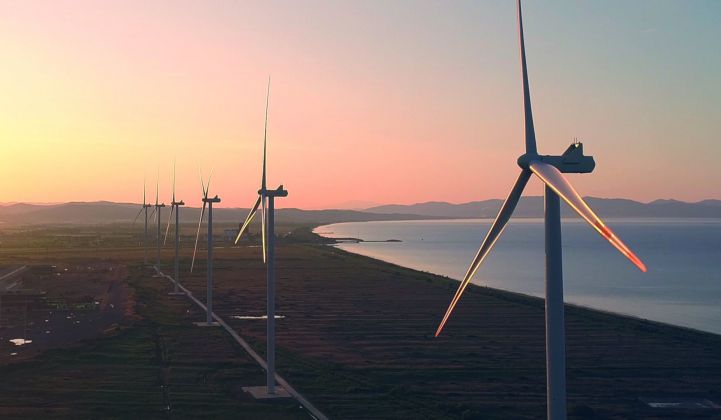From record-low solar prices in Portugal to a massive PV pipeline over the border in Spain, solar has been dominating the energy transition conversation in Southern Europe. Once the economics of solar reached the point of attractive subsidy-free returns, it was all but inevitable.
But tapping Southern Europe's unfulfilled potential for onshore wind will be pivotal to the region's decarbonization goals. That's leading utilities in the region to structure plans to bolster onshore wind's growth in tandem with solar's economics-driven expansion to ensure that the two can serve as mutually supportive renewable resources for an increasingly clean-powered grid.
“[Onshore wind] is a mature technology with attractive pricing,” Brian Gaylord, principal analyst with Wood Mackenzie for Latin America and Southern Europe, said in an interview. By the end of 2019, Europe had 183 gigawatts of installed capacity, compared to 22 gigawatts of offshore wind, according to data from the trade body WindEurope.
“You’ve got a lot of developers that have been working with it for 20 years. They know how to commercialize it and how to adapt to every market," Gaylord said. But Europe's onshore install rates for the combined two-year period of 2018-2019 have not been lower since 2009-2010.
With PV pricing so low, Gaylord warns that renewable auctions, such as those currently being designed in Spain, cannot be technology-neutral because “PV would win everything, and you can’t hit your targets with PV alone.” Setting quotas for each technology could prevent solar from having to be excessively curtailed in years to come.
“If you have to do wind and PV, it's better to spread it out,” he said. Supply chains for both industries can enjoy more stability if they are developed in tandem.
A number of utilities are already addressing this at a fleet level, he said, including Iberdrola. The Spanish utility giant is investing €35 billion ($42.4 billion) in renewables between 2020 and 2025. Gaylord said it is going heavy on solar in Spain right now to balance out its existing onshore wind fleet. But looking at the company’s pipeline across Europe, things are pretty well balanced. It is sitting on 11.3 gigawatts of PV opportunities, 6.6 GW of onshore wind and 9.4 GW of offshore wind.
Lorenzo Palombi is managing director of the developer BayWa r.e.’s business in Italy. The company develops both wind and solar. Pairing both technologies offers a “natural hedge” that will also need to be backed by energy storage and other innovations, he said in an interview.
“If you're just pushing for one technology, then you are in an unbalanced scenario, and [that can] create problems. You should be strategic with a well-thought-out and coordinated approach,” he said.
Palombi said BayWa r.e. is actively working on onshore wind projects in Italy and Spain. It has just made new hires to help it develop projects in Greece, and the company has completed, and sold, its first project in Croatia, with more to follow there and across the Balkans.
Removing barriers to onshore wind development
Italy provides a good example of how a vast market with solid renewable resources and reasonable ambitions can tie itself up in red tape, Palombi said.
Italy’s auctions require projects to be fully permitted. Palombi said the last round attracted 300 MW worth of bids with 1 GW of capacity up for grabs. But local and regional planning can take so long that environmental impact approvals lapse. While the country's Ministry for Cultural Heritage and Activities can extend these on request to prevent projects from having to start over, it has not approved a single one of these requests thus far.
Permits don’t allow for changes in technology, leaving developers with the choice of starting from scratch or utilizing older turbines.
Palombi suggests cleaning out some of the subjective rules used in the permitting process. With objective rules, such as an allowed percentage increase in turbine power and the maximum tip height of the turbines, projects could take advantage of new technology without opening the door to litigation and appeals from opponents in fresh applications, he said.
The next decade could also see Italy repower as much as 8 GW of existing onshore wind capacity, he added. As things stand, the process for repowering is identical to building a greenfield project from a permitting perspective.
Typically, repowering will involve a reduction in the total number of turbines as taller and more powerful systems are installed instead. Objective rules on a tradeoff for turbine heights versus turbine numbers would be one route to a swifter evaluation process, he said.
Across all of Europe, there could be as much as 65 GW of onshore wind looking at repowering by 2028, according to Wood Mackenzie.
The challenges in Italy are pretty common in multiple Southern European markets. The 2030 targets are a strong driver, but permitting and grid challenges present a series of roadblocks.
EU members must submit a National Energy and Climate Plan to authorities in Brussels. Spain’s plan calls for renewables to make up 74 percent of electricity production by 2030. Italy is aiming for 55 percent. On Thursday, the EU signed off on a 2030 target for 55 percent emissions reduction compared to 1990 levels. Italy has no such target at present.
But Palombi doesn’t think this means the Italian government’s renewable plans aren't aggressive enough.
“Italy has to double its wind capacity (to 19.3 GW) and triple its solar (to 52 GW),” he pointed out. Hitting those big numbers will require some persistent hurdles to be removed.




